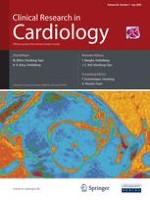01.07.2009 | Clinical Correspondence
Iatrogenic epinephrine-induced reverse Takotsubo cardiomyopathy: direct evidence supporting the role of catecholamines in the pathophysiology of the “broken heart syndrome”
Erschienen in: Clinical Research in Cardiology | Ausgabe 7/2009
Einloggen, um Zugang zu erhalten










